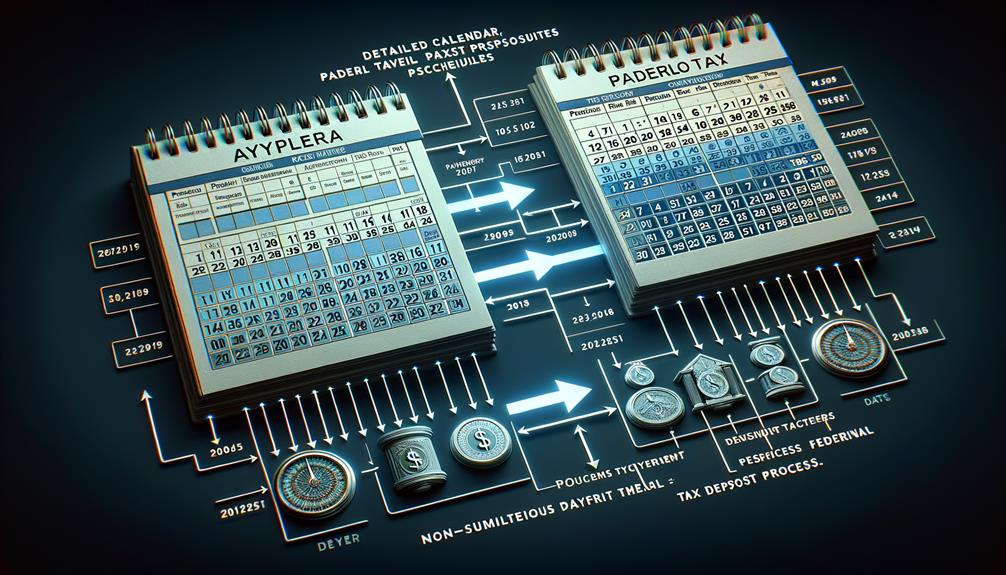Untangling the knot of federal tax deposit frequencies is like solving an intricate puzzle; it’s complex but not impossible.
You see, the key is to separate your payroll processing from tax remittance schedules. This might sound a bit daunting, but it’s absolutely essential to ensure your business remains in compliance with IRS regulations.
Now, you might be wondering, ‘How can I accomplish this and what does it mean for my business?’ Well, let’s get into the heart of the matter and uncover the details.
Key Takeaways
- Federal tax deposit frequencies, determined by owed taxes, influence business cash flow and compliance status.
- Decoupling payroll processing from tax schedules enhances flexibility and eases compliance with tax obligations.
- Understanding and managing tax remittance schedules is crucial for avoiding penalties and maintaining financial health.
- Utilizing payroll software like Patriot Software can aid in adapting to deposit frequency changes and aligning with IRS requirements.
Understanding Federal Tax Deposits

In relation to your federal tax obligations, it’s crucial to understand that the frequency of your federal tax deposits hinges on the amount of federal taxes you owe, which encompasses employee federal income tax, Social Security, and Medicare taxes. This deposit frequency, as defined by the Internal Revenue Service (IRS), is determined within a specific lookback period from July 1, 2022, to June 30, 2023.
Your business is categorized as either a monthly or semi-weekly depositor, depending on the total taxes owed. If your federal tax obligation is $50,000 or less, you’ll fall into the category of a monthly depositor. Conversely, if you owe more than $50,000, you’re classified as a semi-weekly depositor.
It’s important to note that these deposit frequencies aren’t arbitrary but are based on the previous calendar year’s lookback period, from July 1 through June 30. When setting up your payroll deposit frequency in Patriot Software, you can choose between Monthly or Semi-Weekly federal income tax deposit options. Understanding these federal tax deposit frequencies is critical to maintaining compliance and avoiding potential penalties.
Decoding Payroll Processing
Decoding payroll processing involves accurately calculating and distributing employee wages, benefits, and taxes – a crucial step that, when done properly, ensures your business remains in compliance with tax remittance schedules and avoids costly penalties. By understanding the intricacies of this process, you’re not just crunching numbers; you’re creating a financial blueprint that affects every aspect of your business.
When decoding payroll processing, consider these key components:
- Accurate calculation of gross wages: This includes hourly rates, salaries, overtime, bonuses, and commissions.
- Benefits administration: This involves tracking and managing benefits like health insurance, retirement contributions, and paid time off.
- Tax deductions: You need to accurately calculate federal, state, and local taxes based on each employee’s tax bracket.
- Regular review of federal tax deposit frequency: This is to ensure that you’re depositing withheld taxes at the correct intervals to avoid penalties.
In essence, decoding payroll processing isn’t just about managing your employees’ paychecks. It’s about minimizing tax liability and understanding federal tax deposit frequency. By mastering these elements, you can keep your business financially healthy and compliant.
Navigating Tax Remittance Schedules

Navigating tax remittance schedules might seem like a daunting task, but understanding the determining factors for federal tax deposit frequency can simplify the process significantly. Your federal tax deposit frequency is determined by the total tax liability you reported in a four-quarter “lookback” period. If the amount is $50,000 or less, you’re considered a monthly depositor. Otherwise, you fall into the semi-weekly depositor category.
Consider the following table for clarity:
| Lookback Period | Federal Tax Deposit Frequency |
|---|---|
| $50,000 or less | Monthly |
| More than $50,000 | Semi-Weekly |
When setting up your payroll, you’ll need to select from these options in your payroll software. The tax collection for full-service payroll customers is done as payroll is processed, typically the day before the paydate. Remember, the lookback period is defined as the 12-month period ending June 30 of the prior year. Understanding this can help you effectively navigate your tax remittance schedule and ensure you’re compliant with federal tax deposit requirements. It’s a vital part of managing your monthly payroll and maintaining your business’s financial health.
Decoupling Payroll and Tax Schedules
Balancing your business’s payroll schedule with the rigid federal tax deposit deadlines can feel like a high-wire act, but decoupling these two processes can provide a safety net, improving your cash flow management and ensuring timely compliance with tax obligations.
Simply put, decoupling payroll and tax schedules means separating the timing of processing payroll from remitting federal tax deposits. This adjustment can offer you the flexibility you need to manage your business effectively.
To visualize the benefits:
- You can process payroll according to your internal schedule, not the IRS’s.
- Improved cash flow management due to a more flexible payroll schedule.
- Ensuring timely compliance with tax obligations becomes less of a headache.
- You gain the ability to adapt to changes in federal tax deposit frequency with less disruption to your business operations.
Keep in mind, this strategy requires careful coordination to stay in line with IRS requirements. You may need to adjust internal processes and systems to maintain compliance with federal tax deposit frequencies. But in doing so, you create a more streamlined, flexible, and resilient approach to managing your business’s finance.
Managing Business’s Payroll Duties

In the realm of managing your business’s payroll duties, understanding federal tax deposit frequencies is crucial, as these are determined by the amount of federal taxes your business owes, within a lookback period from July 1, 2022, to June 30, 2023.
As you set up your payroll, take note of the two main depositing schedules: monthly and semi-weekly. Businesses owing $50,000 or less in taxes are monthly depositors, while those owing more are semi-weekly depositors. Your Payroll Setup in Patriot Software allows you to select your deposit schedule accordingly.
Here’s a simple table to illustrate:
| Tax Owed | Deposit Schedule | Payroll Setup |
|---|---|---|
| $50,000 or less | Monthly | Select in Patriot Software |
| More than $50,000 | Semi-Weekly | Select in Patriot Software |
To ensure timely remittance, full-service payroll customers have taxes collected as payroll is processed. For a comprehensive understanding of federal tax deposit frequencies, refer to IRS Publication 15, the Employer Tax Guide. Additionally, remember to check with your state and local authorities for their deposit schedules.
Efficiently Meeting Tax Responsibilities
To meet your tax responsibilities efficiently, understanding the intricacies of federal tax deposit frequencies is a must, particularly as it relates to the amount of federal taxes your business owes during the lookback period. Determining your deposit frequency is crucial, as it directly impacts your business’s financial obligations and compliance with IRS guidelines.
Consider the following aspects:
- Your federal tax deposit frequency hinges on the total federal taxes your business owed in the lookback period. If your business owed over $50,000, you’re typically a semi-weekly depositor.
- The lookback period, as defined by the IRS, is from July 1 to June 30 of the previous calendar year.
- Businesses owing $50,000 or less in federal taxes during the lookback period are considered monthly depositors.
- To ensure you’re meeting your tax responsibilities efficiently, adhere to your specific deposit frequency requirements.
Being aware of these factors will enable you to plan your financial strategy better and ensure compliance with IRS guidelines. Understanding the nuances of federal tax deposit frequencies is a critical step in effectively meeting your tax responsibilities.
Frequently Asked Questions
What Are the Frequency of Payroll Tax Deposits?
You’re navigating the maze of payroll taxes. The frequency of tax deposits, impacted by payroll tax reforms, hinges on your owed taxes. Less than $50,000? You’re a monthly depositor. Over that, you’re semi-weekly.
What Determines the Frequency of Deposits of Federal Income Taxes Withheld?
Your deposit frequency for federal income taxes withheld is determined by the total tax liability of your previous lookback period. It’s not related to your payroll processing, but to your tax withholding mechanisms and deposit determinants.
Which of the Following Are Payroll Tax Deposit Frequencies?
You’ve two main payroll tax deposit frequencies: monthly and semi-weekly. These frequency adjustments can pose tax deposit challenges, especially when decoupling payroll processing from tax remittance schedules. It’s crucial to understand and adhere to them.
What Is My Federal Tax Deposit Schedule?
Your Federal tax deposit schedule hinges on your lookback period’s total tax. It’s crucial to meet deposit deadlines to avoid tax penalties. Remember, your payroll process doesn’t dictate your tax remittance schedule.





